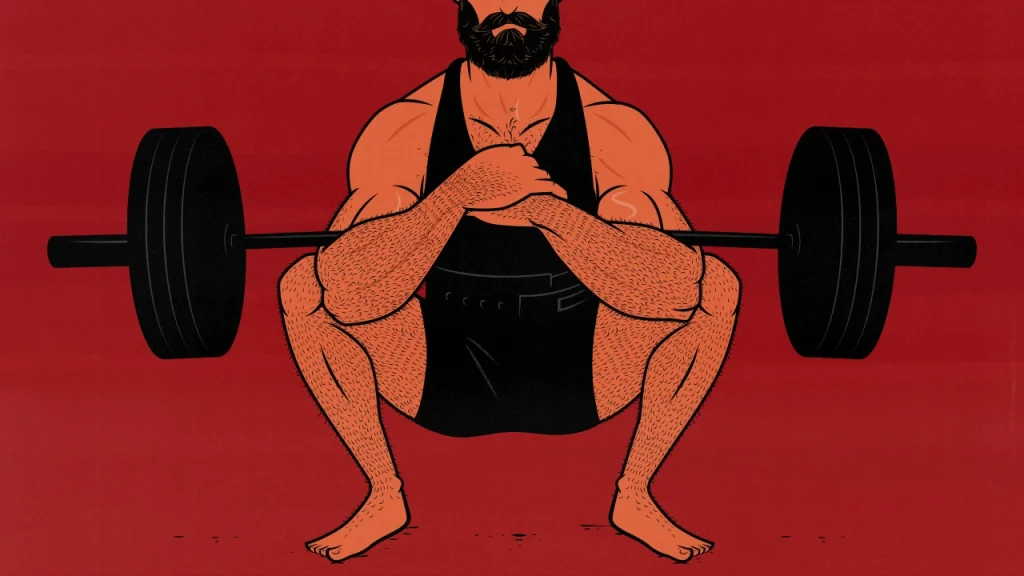
The Best Lower-Body Workout for Building Muscle
“Leg Day” and “Lower Body Workout” sound similar, and indeed they are. The difference is that Leg Days are usually used by bodybuilders, whereas Lower Body Workouts are more often used to gain a mix of size, strength, and athleticism. They’re part of a different training tradition.
When you split your body in two, you can train it half as much but twice as often, making your workouts shorter and easier. Or you could devote more time and energy to the muscles you’re training, increasing the overall stimulation. We’ll show you how.
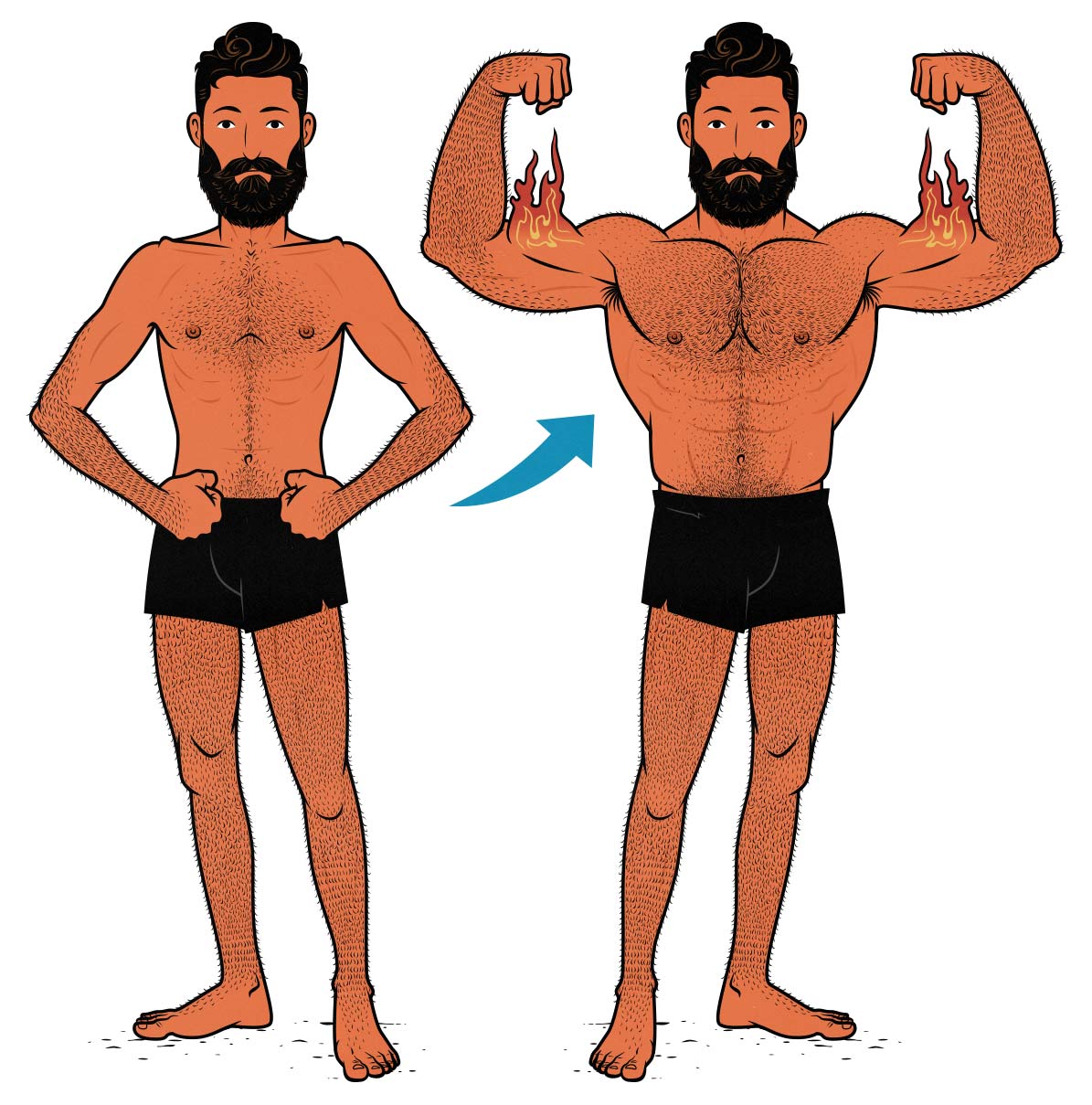
First, A Warning
Long ago, the primeval world was terrorized by a race of giant lizard kings with disproportionately large lower bodies. Great rocks fell from the sky, destroying them. I take that as a warning from the heavens not to repeat their great mistake. Don’t forget to combine these lower-body workouts with upper-body workouts.
What Are Lower-Body Workouts For?
Lower-body days are usually part of Upper/Lower Workout Splits, where you alternate between training your upper body and your lower body, like so:
- Monday: Lower Body Workout <=
- Tuesday: Upper Body Workout
- Wednesday: Rest or Cardio
- Thursday: Lower Body Workout <=
- Friday: Upper Body Workout
- Saturday: Rest or Cardio
- Sunday: Rest
You don’t have to give your upper and lower body equal emphasis, though. I usually like to have 2 lower-body workouts and 3 upper-body workouts. That lets me have one lower-body workout built around squats and another built around deadlifts.
Muscles Worked
Lower-body workouts train the biggest muscles in your body: your quads, glutes, calves, and hamstrings. That’s already quite a lot. But the best leg exercises also tend to demand quite a lot of postural strength. The best lower-body workouts work your traps, spinal erectors, serratus, abs, obliques, and other core muscles.

If you do deadlifts on your lower-body days, you can bulk up all the muscles in your back, too. You don’t need to train those muscles on purpose, but it can make for a nice bonus. Your back muscles will probably appreciate the extra stimulation.
Most people are terrified of deadlifts and the people who do them. I understand why. They stimulate a truly fearsome amount of muscle growth. If you want, you can replace them with good mornings, step-ups, hip thrusts, or hamstring curls.
The Best Lower-Body Exercises
Squats (and Other Quad Exercises)
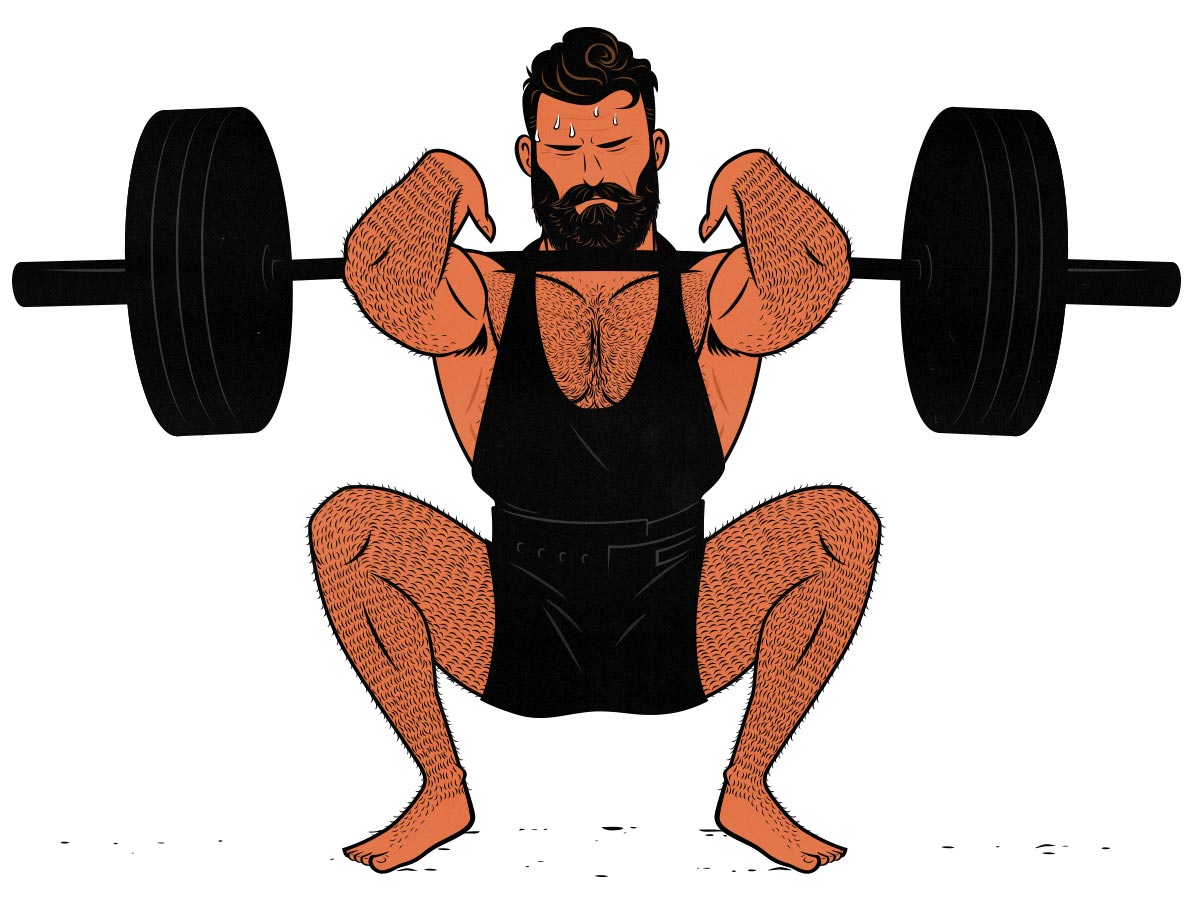
Squats are a knee-dominant exercise that work your quads and glutes—the two largest muscles in your body. If you’re sympathetic to Starting Strength or StrongLifts 5×5, this idea of doing knee-dominant squats may seem foolish—even heretical. We’ve explained everything in our article on squats.
Here are some of the best squat variations for building muscle:
- Goblet squats are ideal for beginners. They’re the easiest to learn, encourage a deep range of motion, and do a great job of bulking up your upper body along with your quads.
- Front squats are my favourite intermediate/advanced squat variation. They encourage a deep range of motion, and they’re fantastic for building bigger quads, a thicker torso, and a sturdier posture.
- High-bar squats are easier on your spinal erectors. They allow you to emphasize your quads without working your postural muscles as hard, making them quite a bit less fatiguing.
- (Bulgarian) split squats allow you to train one leg at a time. This allows you to work your quads with lighter loads, putting less strain on your back. They’re also great for mobility and general strength. They were a staple in Marco’s programs for professional and Olympic athletes. He even tried to get me to do them once.
- Leg presses are great for removing your spinal erectors entirely. They allow you to work your quads through a deep range of motion without any involvement from your postural muscles. That can be nice when your back is tired from deadlifts.
- Leg extensions train your rectus femoris. The rectus femoris has trouble engaging when your hips are moving. By locking your hips into a machine, you can work them much harder.
Deadlifts (and Other Hip Exercises)
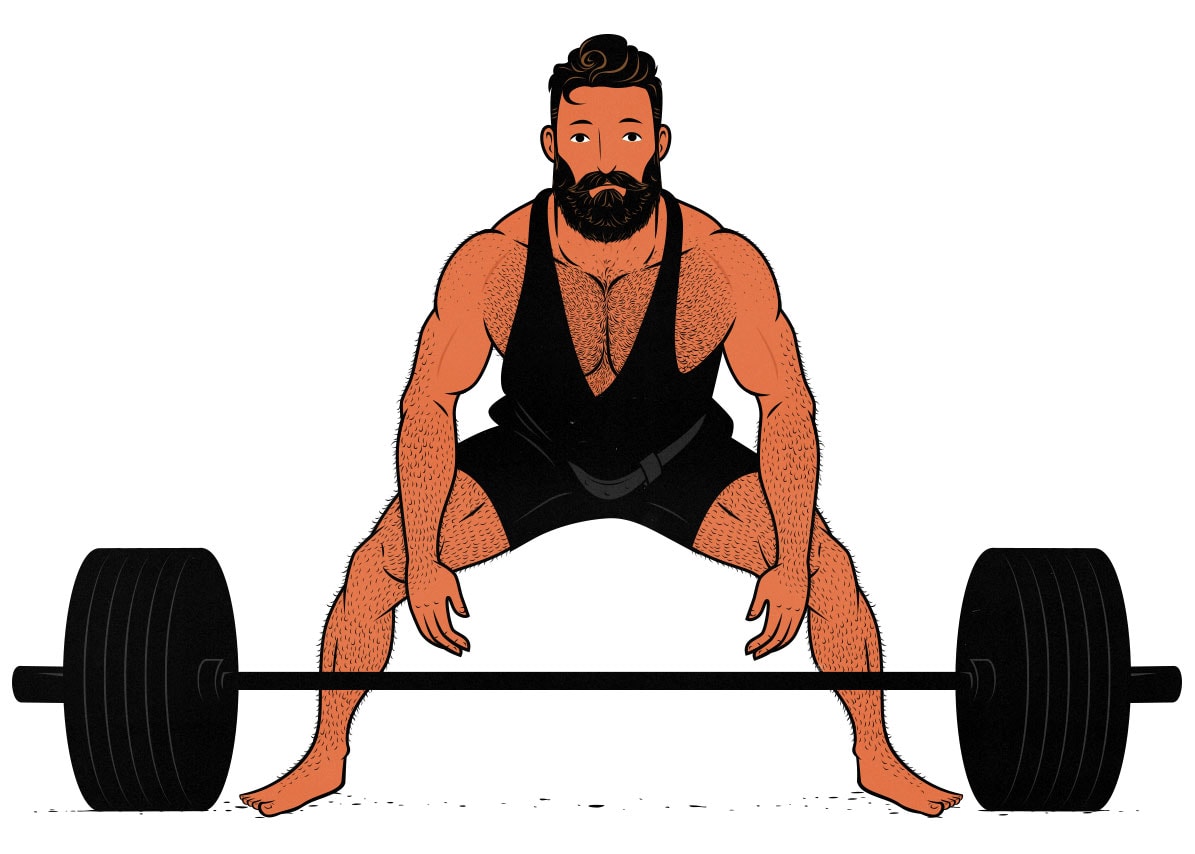
Deadlifts are the king of full-body exercises. Squats work bigger muscles, but deadlifts work more of them, especially in your back. They’re especially good for your glutes, hamstrings, spinal erectors, and traps.
- Conventional deadlifts work your hips and lower back. They’re also great at bulking up almost all of the muscles in your back. They stimulate the most overall muscle growth.
- Romanian deadlifts are better for your hamstrings. Keeping your knees stiff allows your hamstrings to fully engage. They’re the best deadlift variation for your lower body.
- Sumo deadlifts are easier on your lower back. The wider stance keeps your torso more upright, shifting some of the load from your back to your quads. I recommend a narrow sumo stance.
- Trap-bar deadlifts are ideal if you have a trap bar. It’s a more natural movement. The handles are easier to hold onto. Mind you, most people don’t have trap bars.
- Good mornings are easier on your upper back. They’re similar to Romanian deadlifts, but the barbell rests on your back, taking your upper back out of the equation and keeping the emphasis on your lower body.
- Step-ups and lunges work your hips and quads. They’re a hybrid between squats and deadlifts. They’re great for working your legs without tiring out your back. They’re also great for improving athletic performance.
- Hip thrusts can be good for emphasizing your hips. Barbell hip thrusts are difficult to set up and aren’t any better for your glutes than squats or deadlifts. However, I quite like one-legged hip thrusts. You can do them on a bench, perhaps with a dumbbell in your lap. They’re great for giving your glutes some extra stimulation at the end of a hard workout.
Calf Exercises
Your calves aren’t worked very hard during compound exercises. They cross both your knee and ankle joints, so when there’s movement at the knees, they have trouble engaging. If you rely on compound lower-body exercises, as I have, you may find that your calves lag, as mine did. It’s up to you whether you consider that a problem.
Some people build muscular calves from walking and running. That’s especially true for people who carry around body fat or weighted rucksacks. It isn’t a very efficient way of building bigger calves, but if you’re doing it anyway, it may very well be enough. That’s how I train my calves. I jog and ruck.
Calf raises are by far the most efficient way to build bigger calves.
- Deep calf raises are fantastic for building bigger calves. Ideally, you’d do them standing, lengthening your calves at the knee joint. You can also raise your toes up on a platform or weight plate, allowing you to lower your heels until your calves burn with a deep stretch. Smith machines can be great for this. The barbell will add weight and help you balance.
I usually like to make jokes about how Milo of Croton invented calf raises, but I won’t do that here.
Core Exercises
You don’t need to isolate your abs and obliques. They might already get plenty of stimulation during your upper-body workouts. Mine get worked pretty hard during chin-ups, pull-ups, and weighted push-ups.
However, ab exercises often slot pretty nicely into lower-body workouts. You can even superset them between your sets of squats and deadlifts.
- Hanging knee raises and leg raises are great for your abs. Start with knee raises. When those get too easy, progress to leg raises. If your squat rack has a chin-up bar, you can superset them between your sets of squats.
- Crunches are another great ab exercise. You can do crunches on a bosu ball to train your abs under a deeper stretch, weighted cable crunches to load your abs heavier, or reverse crunches to emphasize your lower abs.
- Side planks are great for your obliques and smaller glute muscles. You can work your glute max quite hard with squats and deadlifts, but your gluteus medius and minimus might lag behind. Side planks are a simple way to give them some extra stimulation. Rest a weight plate or dumbbell atop your hips when side planks get too easy.
The Lower-Body Workouts
There are a few different ways you can program Upper/Lower Splits. Maybe you use undulating periodization, where you alternate between a heavier and a lighter upper-body workout. Perhaps you have one lower-body workout built around the squat and the other built around a deadlift. We’ll cover both approaches.
4-Day Undulating Periodization Workouts
These lower-body workouts are part of a 4-day split that uses undulating periodization. They’re great for gaining size, and they’re fantastic for gaining maximal strength and power—especially if you use one of the customization options at the end of the article.
| EXERCISE | SETS | REPS |
|---|---|---|
| Deadlifts | 4 sets | 5 reps |
| Front Squats | 4 sets | 5 reps |
| Leg Press | 3 sets | 8 reps |
| Step-Ups | 3 sets | 10 reps |
The first workout is the heavier lower-body day. The main emphasis is on getting strong at squats and deadlifts. The leg press gives your quads some extra volume. Step-ups are a similar movement pattern to the deadlift, but they train your legs unilaterally—an important part of training for sports performance.
| EXERCISE | SETS | REPS |
|---|---|---|
| Leg Press | 4 sets | 12 reps |
| Romanian Deadlift | 3 sets | 12 reps |
| Split Squats | 3 sets | 12 reps |
| Calf Raises | 3 sets | 15 reps |
The second workout is designed to stimulate muscle growth. We’re training the same movement patterns, but we’re choosing exercise variations that make it easier to train in a moderate rep range.
You can use any variation of split squats. Maybe that’s a regular split squat, Bulgarian split squat, or a Zercher front-foot-elevated split squat.
If you’re training for athletic performance, you might want to swap those calf raises out for a rotational core exercise, like a cable rotation or Pallof press. If you’ve never done a rotational core exercise before, here’s Marco teaching a half-kneeling Pallof press. That’s a great place to start.
5-Day Size & Strength Workouts
These lower-body workouts are part of a 5-day split designed to get you big and strong. This is the training split we use in our Outlift Intermediate Hypertrophy Program. It’s incredibly good for gaining muscle size and strength. It’s one of my favourite ways to bulk up.
Here’s how it works. There are two lower-body workouts, each focused on one of the two big lower-body exercises: squats and deadlifts. However, you’ll get better results if you train your muscles twice per week, so both workouts train your entire lower body.
| Exercise | Sets | Reps |
|---|---|---|
| Deadlift | 3 sets | 6-8 reps |
| Crunches | 3 sets | AMRAP |
| High-Bar Squat | 3 sets | 8-12 reps |
| Neck Curls | 3 sets | 12–15 reps |
Deadlift Day is built around a variation of the deadlift (such as a conventional deadlift). Put your best effort into those deadlifts. The assistance exercises are there to stimulate the rest of your lower-body muscles.
| Exercise | Sets | Reps |
|---|---|---|
| Front Squat | 4–5 sets | 6-12 reps |
| Hanging Leg Raises | 3–4 sets | AMRAP |
| Romanian Deadlift | 2–3 sets | 8-15 reps |
| Neck Curls | 3 sets | 12–15 reps |
Squat Day is built around a variation of the squat (such as a front squat). If you’re squatting in a squat rack, you’ll have a pull-up bar handy, giving you an opportunity to do hanging leg raises as a superset.
You can superset your Romanian deadlifts with neck curls, but you don’t need to do neck curls. If you want, you could swap them for side planks, split squats, or a rotational core exercise.
If you want even bigger quads and hamstrings, you can add 3 sets of leg curls and leg extensions. If you’d like bigger hips, you could add 3 sets of one-legged hip thrusts. Take those sets to failure.
Customizing the Workouts for Strength
If you want to gain more maximal strength, start your workouts with a post-activation potentiation (PAP) set for the first exercise. I got this trick from the world-record-holding powerlifter, Greg Nuckols. You’d do progressively heavier warm-up sets until you’re lifting about 110% of the weight you’ll use in your first working set. Do 2–3 heavy reps, stopping 2–3 reps shy of failure. Lift explosively, using your full strength to accelerate the weight through the bottom of the range of motion.
Your muscles prefer to ration their energy. They hold back, saving some of their strength for later. The idea with these heavy warm-up sets is to contract your muscles as powerfully as you possibly can, teaching your muscles how to fully engage for an all-out surge of effort.
Do one of those heavy warm-up sets, rest for 3 minutes, then begin your first working set. The weight should feel a bit lighter than usual.
Next week, add 5 pounds to that heavy warm-up set.
Customizing the Workouts for Athleticism
If you want to develop your athleticism, start your lower-body workouts with a few sets of sprints. When Marco was training college, professional, and Olympic football and rugby players, he would start their workouts with sprints to improve their running performance.
You could start by doing 4 sets of 10-metre sprints, with a minute of rest between each set. Rest for 3 minutes after the final set, then start your lower-body workout.
If you’re familiar with this type of training, you could start with 4 sets of sprints with falling starts, rest for 3 minutes, then do 4 sets of sprints with push-up starts.
Neck Training
If you play a contact sport, you should probably include some neck training in your workout routine. I don’t recommend bashing your head into things, but if you must, it’s better to be built like a bull.
Neck exercises fit nicely into lower-body workouts. You can superset neck curls between your sets of squats and deadlifts. It’s nice because neck curls are such a small exercise. They give you a bit of extra rest before you need to get back under a horrifically heavy barbell.
Workout Guidelines
Lower-body workouts are part of the strength and performance tradition. This is how athletes build muscle. That means focusing on progressive overload, getting enough rest between sets, and lifting with an explosive tempo.
- Volume: Each workout has 4 exercises for 3–5 sets. That may not sound like much, but lower-body workouts can be surprisingly challenging. Add more if you want more.
- Progression: The goal is to gradually get stronger at the bigger exercises. In the 4-day routine, that means fighting to add weight on heavy days. In the 5-day routine, that means giving your best effort to the first exercise of every workout.
- Rest times: If you’re supersetting the exercises, rest for 2 minutes between sets. If you aren’t supersetting, rest for 3–5 minutes between sets. Use shorter rest times for the smaller exercises.
- Reps in Reserve: Leave 2–3 reps in reserve on your heavier exercises. Leave 1–2 reps in reserve on your smaller exercises. You can take some of the smaller exercises (like calf raises) all the way to failure, especially on the final sets.
- Explosive Tempo: Lift the weights powerfully, accelerating them through the beginning of the range of motion. Lower the weights slowly and under control. Give each rep your full effort.
- Diet: You need to eat enough food to fuel muscle growth. If you’re skinny-fat or overweight, you can recomp, getting the extra energy you need from your body fat. If you’re thin or lean, you’ll need to bulk.
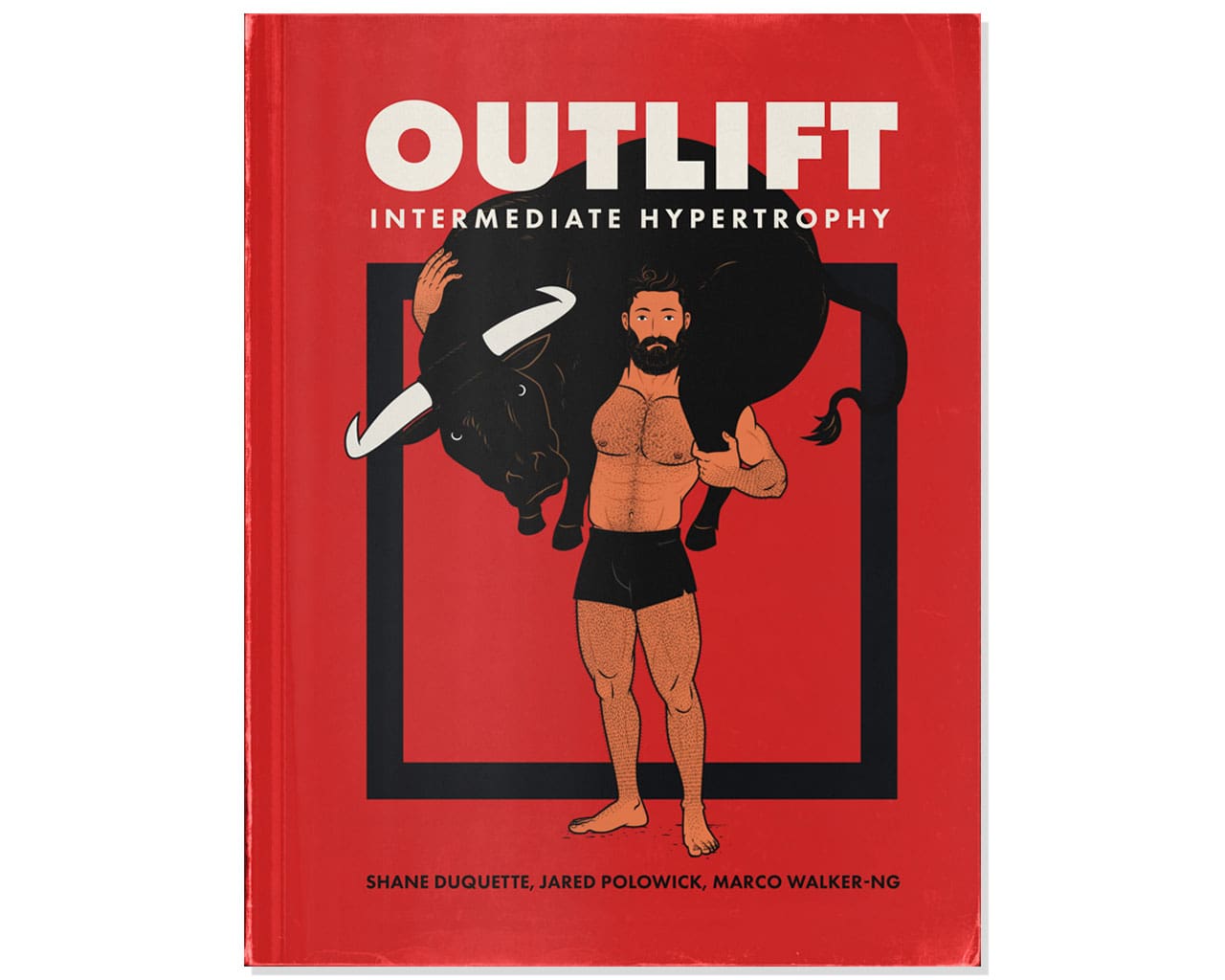
If you want a fully optimized 3-day, 4-day, and 5-day workout split, check out our Outlift Intermediate Hypertrophy Program. It’s a 15-week customizable workout routine with guided progressive overload. It also comes with a full hypertrophy training guide. I think you’d really like it.



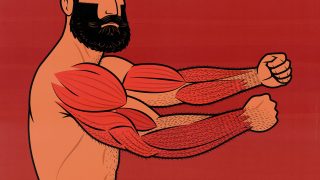

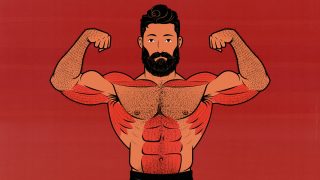
Those great lizard beasts ruled for over 100 million years. Not too shabby. Humans have only been around for around 300,000 years. Seems to me the dinos’ lower body prowess is a good model for us. How else will we summon the strength to fend off the impending AI apocalypse?
I jest. But seriously, I’m surprised you recommend supersetting big lifts with core work. My concern is that tired abs could hinder my squat and deadlift capabilities on subsequent sets. I’d love to be convinced otherwise, though, because the efficiency of supersets makes me as happy as a t-rex who just hunted down a triceratops.
That’s a really good question. Squats and deadlifts can be limited by the strength of your spinal erectors, so I wouldn’t superset back extensions. Your abs, obliques, and transverse abdominis will engage, but they aren’t limiting factors. If you do a set of crunches and then a set of squats, your abs will be fine. I’m sure there are exceptions, but that’s true for the vast majority of people.
You may even find that working your core during your rest periods helps your core and posture feel more engaged during your squats and deadlifts.
Your abs get worked harder during lifts like L-sit chin-ups and weighted push-ups. That’s where supersetting with ab exercises might interfere.
I take your point about the lizard kings, but they only lived at the very end of the Late Cretaceous. It seems that shortly after they rose to power, the heavens smote them. We don’t know yet whether the heavens would smite us for building disproportionately large lower bodies.
If we’re speaking more generally, mammals have been around for over 200 million years. We were allowed to survive. And look at how we’re built, right? Bears, cheetahs, and gorillas aren’t exactly known for their large legs. Whales abandoned them entirely.
Nicely argued on all sides. I’ll try the ab superset and see if it works.
Our fellow primate gorillas do skip leg day. But every day is lower body day for the four-legged bulk of mammals. Lions and tigers don’t need big biceps to strike fear in the hearts of their prey! The bear split is trickier to name given that the front limbs can be used for running or swatting. Whales are a different beast altogether…
Let me know how it goes! Usually you’d stop a little shy of failure on those ab sets. Keep some energy in reserve.
You’re making a horrifying point. If I understand you correctly, you aren’t counting forelimbs as part of the upper body. You might even count all four limbs as the lower body. That’s like imagining the glimmering stars of night sky as a creature that never blinks, staring down at us with its million eyes. I would say it isn’t true, but what if it takes offence?
I tried supersetting some ab exercises with squats and that seemed to work well. I’ll do it with deadlifts on Monday. I see the value here as you get efficiency and extra ab activation/engagement.
Call me old school, but I consider any limb that makes constant, direct contact with the ground during ambulation to be part of the “lower” body. You don’t get much lower than the ground. Fear not: us two-leggeds get some relief from the overwhelming challenge of endless lower body day.
As far as the night sky creature is concerned, my understanding is that it is a benevolent being that only fails to blink on account of its sheer enjoyment of the show. Unless you skip lower body day, of course.